Evolution and Control of Air Pollution in China over the Past 75 Years: An Analytical Framework Based on the Multi-Dimensional Urbanization
Abstract
:1. Introduction
2. Literature Review
3. Research Design and Methodology
3.1. Data Description of Air Pollution
3.2. Data Description of Urbanization
3.3. Methodology for the Division of Interactive Stages
4. Air Pollution and Urbanization in China: Dilemma and Twilight
4.1. Initializing Urbanization Path and Dust Pollution (1949~1978)
4.1.1. The “Soviet Model” of Urbanization and a Light Dust Pollution
4.1.2. A Decade of Divergent Urbanization and the Initial Advancement of Air Pollution Control
4.2. Urbanization on Track and Compound Coal-Smoke Pollution (1979~1990)
4.2.1. The Rise of SMEs and the Prevalence of Low-End Processing Industries Caused Coal-Smoke Pollution
4.2.2. Infrastructure Construction and Gradually Improved Overall Appearance of City
4.3. Accelerating Urbanization and Acid Rain Pollution Outbreak (1991~1999)
4.3.1. Land Urbanization Promotes Industrialization
4.3.2. Accelerated Industrialization and Aggravated Coal-Smoke Pollution
4.3.3. Urban Infrastructure Improvement and Motor Vehicle Exhaust Emission
4.3.4. Preventing the Overheating of the Urban Economy and the Drastic Drop in Pollution Emissions in 1997
4.4. The “Golden Period” of Urbanization and the Full Outbreak of Air Pollution (2000~2012)
4.4.1. The Establishment of a Modern Industrial System and the Full-Scale Outbreak of Acid Rain Pollution
4.4.2. Greenhouse Gas (GHG) Emission Reduction and Energy Structure Optimization
4.4.3. Soaring Consumption of Housing and Automobiles and the Prominence of Haze Pollution
4.4.4. The Early Stage of Coordinating Urbanization and Haze Pollution Control
4.5. The Adjustment of Urbanization Model and Entering the Crucial Period of Air Pollution Control (2013~2023)
4.5.1. The Guiding Ideology of “People-Oriented” and the All-Round Structural Adjustment of Urbanization
4.5.2. Structural Adjustment of Urbanization and Effectiveness of Air Pollution Control
5. Discussion: The Interactive Features between Urbanization and Air Pollution Control in the Past 75 Years in China
6. Conclusions and Implications
- (1)
- The notable features of air pollution are discussed in association with the vigorous process of urbanization in China, which can be further divided into five stages including “hard exploration of urbanization path relative to smog dust pollution” (1949~1978), “urbanization on track with compound coal combustion pollution” (1979~1990), “accelerated urbanization with acid rain pollution outbreak” (1991~1999), “the golden period of urbanization in the full-scale explosion of air pollution” (2000~2012) and “synchronizing urbanization model adjustment and air pollution control” (2013~2023);
- (2)
- Among them, the first stage belongs to “low pollution without treatment”, where urbanization and air pollution are basically irrelevant to each other. The second to third stages belong to “pollution first and then treatment”, the fourth stage belongs to “pollution while treatment”, and the fifth stage belongs to “pollution control and prevention”. Air pollution drove urbanization to adjust, and urbanization and air pollution entered into an interactive coupling phase;
- (3)
- Due to a series of problems in China’s urbanization process, such as “urbanization lags behind industrialization”, “infrastructure construction lags behind air pollution control”, “emphasis on construction rather than governance, economy rather than ecology”, and “immediate benefits rather than long-term benefits”, air pollution has shown the characteristics of “from single-pollutant pollution sources to various-pollutant pollution sources”, “local pollution to regional pollution change”, “light pollution to heavy composite pollution change” and “old pollution problems have not been solved while new pollution problems continue to appear”;
- (4)
- As the contradiction between urbanization and air pollution becomes more and more irreconcilable, China’s urban air pollution governance approach began to transition from the previous “treating the symptoms” to “structural adjustment of urbanization and high-quality urbanization”, and entered into the new stage of “urbanization model adjustment and air pollution governance unification”.
- (1)
- At the theoretical level, academics need to further clarify whether air pollution is a “stage” or a “structural” problem in the process of urbanization; that is, according to the environmental Kuznets curve theory, whether air pollution is a stage product of urbanization and whether air pollution will be cured when urbanization crosses a certain threshold, or whether air pollution is caused by a specific urbanization structure. If the problem of a specific urbanization structure cannot be fully solved, an air pollution problem will still accompany the whole process of urbanization, which is an important theoretical basis for China and other developing countries to correctly view the relationship between urbanization and air pollution governance and to formulate governance measures in the future.
- (2)
- Moreover, regardless of whether air pollution is a phase or structural problem of urbanization, in the process of adjusting the model of high-quality urbanization in the future, academics need to further clarify how to optimally adjust the dozens of indicators of urbanization in the demographic, industrial, spatial and social development dimensions in order to ensure the achievement of economic growth goals, while ensuring that air pollution is controlled within a certain range, and trying to propose multiple scenarios for achieving multiple goals (e.g., air pollution control goals, economic growth goals, etc.). This is an imperative for China and other developing countries to achieve the “triple win” of urbanization, air pollution control and economic growth.
- (3)
- In addition, from the perspective of government policymaking, the government needs to further introduce various preventive legal policy documents to prevent potential air pollution problems such as O3, VOCs (Volatile Organic Compounds) and CO during the transition phase of urbanization pattern adjustment in the future. Based on the experience of air pollution collaborative governance in urban clusters, how to promulgate relevant documents to promote the collaborative governance of various types of air pollution will be a major practical issue that China needs to deeply think about in the name of achieving its air pollution governance efforts, and the goals of carbon emission peaking by 2030 and carbon neutrality by 2060. This requires joint efforts of academia and governmental departments, combining theory and practical decisions so as to truly achieve the thorough governance of air pollution in the process of high-quality urbanization.
Author Contributions
Funding
Institutional Review Board Statement
Informed Consent Statement
Data Availability Statement
Conflicts of Interest
Appendix A. The List of Air Pollution and Urbanization Indicators
| Dimensions | Indicators | Connotation | Unit | Time Interval | Data Source | |
| Air pollution | CO2 | One of the main components of GHG, the data over the period 1960–1964 are from PKU data, and the data over the period 1965–2019 are calculated by BP. | million tons | 1960~2023 | PKU Series Emission Inventory (PKU), Wind database | |
| CO | Pollutants emitted by inadequate combustion of fossil fuels and car exhausts. | ten thousand tons, μg/m3 | 1960~2012, 2013~2023 | PKU, China Environmental Monitoring Station (CEMS) | ||
| PM2.5 | The main components of haze pollution, and the main source is industrial production. | |||||
| PM10 | The main component of haze pollution, and the main sources are sand and dust. | |||||
| SO2 | The main component of acid rain, and the main source is the combustion of high-sulfur coal. | |||||
| NOx (NO2) | The main components of acid rain and photochemical smog, and the main sources are automobile exhaust and industrial production. | |||||
| TSP | The sum of all types of particulate matter suspended in the air. | ten thousand tons | 1960~2012 | |||
| O3 | Harmful to human respiratory system, the source is automobile exhausts and chemical reaction. | μg/m3 | 2013~2023 | CEMS | ||
| Population Development | City size | The number of prefecture-level cities | The number of prefecture-level and above cities in China including prefecture-level cities, provincial capitals, and municipalities directly under the central government. | units | 1949~2023 | Compilation of Statistical Data for 60 Years of China, China Statistical Yearbook, China City Statistical Yearbook |
| Population of more than 2 million (in 1986, the caliber of urban population statistics changed, from registered population to non-agricultural population) | The number of cities with a population of more than 2 million, which was the threshold defining mega-cities before 2000. | 1953~1999 | ||||
| Population of more than 4 million (in 2000, the caliber of urban population statistics changed again, from non-agricultural population to permanent resident population) | The number of cities with a population of more than 4 million, which is the threshold defining mega-cities after 2000. | 2000~2023 | ||||
| Population of 2 to 4 million | The number of cities with a population of more than 2 million to 4 million, which is the threshold defining mega-cities after 2000. | |||||
| Population of 1 to 2 million | The number of cities with a population of 1 million to 2 million. Before 2000, it was the threshold for mega-cities, and it was the threshold for large cities after 2000. | 1953~2023 | ||||
| Population under 1 million | The number of cities with a population of less than 1 million, including all small- and medium-sized cities. | |||||
| Population size | Urban population | Total population within a city. | ten million people | 1949~2023 | ||
| Urban population density | The number of residents within unit area of urban area. | people/km2 | 1981~2023 | |||
| Population urbanization | The urbanization rate of registered population, which is estimated by urban registered population divided by total population. | % | 1949~2023 | |||
| Urbanization growth rate | The rate of increase in urbanization compared to that of previous year. | % | 1950~2023 | |||
| Economic development | Economic Growth | GDP | City GDP. | CNY billion | 1952~2023 | |
| GDP per capita | City GDP per capita | CNY | ||||
| Industrial value | Urban industrial value. | CNY billion yuan | ||||
| Proportion of industrial value | The proportion of industrial value in the city’s GDP. | % | ||||
| Tertiary industry output value | GDP of the city’s tertiary industry. | CNY billion | ||||
| Proportion of tertiary industry output value | The proportion of the tertiary industry’s GDP in a city’s GDP. | % | ||||
| Disposable income per capita | Urban disposable income per capita. | CNY | 1978~2023 | |||
| Energy consumption | Total energy consumption | The total consumption of various types of energy in a city is equivalent to standard coal consumption. | ten thousand tons | 1953~2023 | ||
| Coal consumption ratio | Coal consumption as a proportion of total energy consumption. | % | ||||
| Crude oil consumption ratio | Crude oil consumption as a proportion of total energy consumption. | % | ||||
| Natural gas consumption ratio | The proportion of natural gas consumption in total energy consumption. | % | ||||
| Other energy consumption ratio | The proportion of water and nuclear energy consumption in total energy consumption. | % | ||||
| Space development | Urban built-up area | Total area of urban built-up area. | ten thousand km2 | 1981~2023 | ||
| Industrial land area | Urban industrial land area. | thousand km2 | 2001~2023 | |||
| Building construction area | Urban construction land area. | thousand km2 | 1995~2023 | |||
| Public green area per capita | Per capita public green area in a city. | m2 | 1981~2023 | |||
| Proportion of land used for housing | The proportion of urban construction land in built-up area. | % | 1995~2023 | |||
| Proportion of industrial land | The proportion of urban industrial land in built-up area. | % | 2001~2023 | |||
| Green coverage rate in built-up area | The proportion of urban gardens and green areas in the built-up area. | % | 1986~2023 | |||
| Social development | Natural gas | Natural gas consumption of urban residents. | million m3 | 1972~2023 | ||
| Liquefied petroleum gas | Consumption of liquefied petroleum gas by urban residents. | 100 t | ||||
| Artificial gas | Artificial gas consumption of urban residents. | ten thousand m3 | ||||
| Civilian car ownership | Urban civilian car ownership. | thousand units | 1949~2023 | |||
| Heating area | Heating area for urban residents. | ten thousand m2 | 1981~2023 | |||
| Road area | City road area. | ten thousand m2 | 1972~2023 | |||
| Road area per capita | Urban road area per capita. | m2 | 1981~2023 | |||
| The number of buses owned per 10,000 people | The number of buses per 10,000 people in a city. | units | 1986~2023 | |||
References
- Dong, F.; Wang, Y.; Su, B.; Hua, Y.; Zhang, Y. The process of peak CO2 emissions in developed economies: A perspective of industrialization and urbanization. Resour. Conserv. Recycl. 2019, 141, 61–75. [Google Scholar] [CrossRef]
- Ministry of Environmental Protection of the People’s Republic of China. Bulletin of the State of the Environment in China. 2013. Available online: http://www.mee.gov.cn/hjzl/sthjzk/zghjzkgb/201605/P020160526564151497131.pdf (accessed on 27 May 2020).
- Zhang, Q.; Robert, C. Toward an Environmentally Sustainable Future: Country Environmental Analysis of the People’s Republic of China; Asian Development Bank: Mandaluyong City, Philippines, 2012; Available online: https://ccus.nwu.edu.cn/__local/E/DC/54/EA2217116CC1501278DB7A42B29_EB5BE3B7_29457A.pdf (accessed on 1 December 2020).
- World Health Organization. 9 out of 10 People Worldwide Breathe Polluted Air, but More Countries Are Taking Action; World Health Organization: Geneva, Switzerland, 2018. Available online: https://www.who.int/news/item/02-05-2018-9-out-of-10-people-worldwide-breathe-polluted-air-but-more-countries-are-taking-action (accessed on 1 December 2020).
- Yin, P.; Brauer, M.; Cohen, A.J.; Wang, H.; Li, J.; Burnett, R.T.; Stanaway, J.D.; Causey, K.; Larson, S.; Godwin, W.; et al. The effect of air pollution on deaths, disease burden, and life expectancy across China and its provinces, 1990–2017: An analysis for the Global Burden of Disease Study 2017. Lancet Planet. Health 2020, 4, e386–e398. [Google Scholar] [CrossRef]
- Diao, B.; Ding, L.; Zhang, Q.; Na, J.; Cheng, J. Impact of urbanization on PM2.5-related health and economic loss in China 338 cities. Int. J. Environ. Res. Public Health. 2020, 17, 990. [Google Scholar] [CrossRef]
- Li, H.; Zhou, D.; Wei, Y. Dynamic Assessment of PM2.5 Health Damage Value in China from 2015 to 2018. Environ. Sci. 2020, 41, 5225–5235. [Google Scholar]
- Fuller, R.; Landrigan, P.J.; Balakrishnan, K.; Bathan, G.; Bose-O’Reilly, S.; Brauer, M.; Caravanos, J.; Chiles, T.; Cohen, A.; Corra, L.; et al. Pollution and health: A progress update. Lancet Planet. Health 2022, 6, 535–547. [Google Scholar] [CrossRef]
- Health Effects Institute. State of Global Air 2024; Special Report; Health Effects Institute: Boston, MA, USA, 2024; Available online: https://www.stateofglobalair.org/sites/default/files/documents/2024-06/soga-2024-report_0.pdf (accessed on 1 July 2024).
- Kuźma, Ł.; Kurasz, A.; Dąbrowski, E.J.; Dobrzycki, S.; Bachórzewska-Gajewska, H. Short-Term Effects of “Polish Smog” on Cardiovascular Mortality in the Green Lungs of Poland: A Case-Crossover Study with 4,500,000 Person-Years (PL-PARTICLES Study). Atmosphere 2021, 12, 1270. [Google Scholar] [CrossRef]
- Feng, L.; Liao, W. Legislation, plans, and policies for prevention and control of air pollution in China: Achievements, challenges, and improvements. J. Clean. Prod. 2016, 112, 1549–1558. [Google Scholar] [CrossRef]
- Lu, X.; Zhang, S.; Xing, J.; Wang, Y.; Chen, W.; Ding, D.; Wu, Y.; Wang, S.; Duan, L.; Hao, J. Progress of air pollution control in China and its challenges and opportunities in the ecological civilization era. Engineering 2020, 6, 1423–1431. [Google Scholar] [CrossRef]
- Jin, Y.; Andersson, H.; Zhang, S. Air pollution control policies in China: A retrospective and prospects. Int. J. Environ. Res. Public Health 2016, 13, 1219. [Google Scholar] [CrossRef]
- Yuan, X.L.; Li, Z.P.; Fang, K. Retrospect and Prospect of Research on Air Pollution in the China’s Urbanization. Econ. Perspect. 2019, 05, 88–103. [Google Scholar]
- Tu, M.; Liu, Z.; He, C.; Fang, Z.; Lu, W. The relationships between urban landscape patterns and fine particulate pollution in China: A multiscale investigation using a geographically weighted regression model. J. Clean. Prod. 2019, 237, 117744. [Google Scholar] [CrossRef]
- Liu, Y.; Wu, J.; Yu, D. Characterizing spatiotemporal patterns of air pollution in China: A multiscale landscape approach. Ecol. Indic. 2017, 76, 344–356. [Google Scholar] [CrossRef]
- Zhou, Q.; Zhong, S.; Shi, T.; Zhang, X. Environmental regulation and haze pollution: Neighbor-companion or neighbor-beggar? Energy Policy 2021, 151, 112183. [Google Scholar] [CrossRef]
- Shao, S.; Li, X.; Cao, J. Urbanization promotion and smog control in China. Econ. Res. J. 2019, 54, 148–165. [Google Scholar]
- Long, Y.; Wu, K. Several realistic problems of urbanization in China: Spatial expansion, population shrinking, low-density human activity and urban defining. Urban Plan. Forum 2016, 2, 72–77. [Google Scholar]
- Liu, R.; Shi, L. The ownership basis of delayed urbanization in China: Theoretical and empirical evidence. Econ. Res. J. 2015, 50, 107–121. [Google Scholar]
- Du, Y.; Sun, T.; Peng, J.; Fang, K.; Liu, Y.; Yang, Y.; Wang, Y. Direct and spillover effects of urbanization on PM2.5 concentrations in China’s top three urban agglomerations. J. Clean. Prod. 2018, 190, 72–83. [Google Scholar]
- Xu, S.C.; Miao, Y.; Gao, C.; Long, R.-Y.; Chen, H.; Zhao, B.; Wang, S.-X. Regional differences in impacts of economic growth and urbanization on air pollutants in China based on provincial panel estimation. J. Clean. Prod. 2019, 208, 340–352. [Google Scholar] [CrossRef]
- Yang, Y.; Tang, D.; Yang, X. Investigating the spatio-temporal variations of the impact of urbanization on haze pollution using multiple indicators. Stoch. Environ. Res. Risk Assess. 2021, 35, 703–717. [Google Scholar] [CrossRef]
- Song, W.; Wang, C.; Chen, W.; Zhang, X.; Li, H.; Li, J. Unlocking the spatial heterogeneous relationship between Per Capita GDP and nearby air quality using bivariate local indicator of spatial association. Resour. Conserv. Recycl. 2020, 160, 104880. [Google Scholar] [CrossRef]
- Li, Z.; Yuan, X.; Xi, J.; Yang, L. The objects, agents, and tools of Chinese co-governance on air pollution: A review. Environ. Sci. Pollut. Res. 2021, 28, 24972–24991. [Google Scholar] [CrossRef] [PubMed]
- Sun, L.; Zhang, T.; Liu, S.; Wang, K.; Rogers, T.; Yao, L.; Zhao, P. Reducing Energy Consumption and Pollution in the Urban Transportation Sector: A Review of Policies and Regulations in Beijing. J. Clean. Prod. 2020, 285, 125339. [Google Scholar] [CrossRef]
- Fang, L.; Li, P.; Song, S. China’s urban development policies and city growth dynamics: An analysis based on the Gibrat’s Law. Int. Rev. Econ. Financ. 2017, 52, 322–329. [Google Scholar] [CrossRef]
- Wang, R.; Tao, S.; Ciais, P.; Shen, H.Z.; Huang, Y.; Chen, H.; Shen, G.F.; Wang, B.; Li, W.; Zhang, Y.Y.; et al. High-resolution mapping of combustion processes and implications for CO2 emissions. Atmos. Chem. Phys. 2013, 13, 5189–5203. [Google Scholar] [CrossRef]
- Liu, Z.; Guan, D.; Wei, W.; Davis, S.J.; Ciais, P.; Bai, J.; Peng, S.; Zhang, Q.; Hubacek, K.; Marland, G.; et al. Reduced carbon emission estimates from fossil fuel combustion and cement production in China. Nature 2015, 524, 335–338. [Google Scholar] [CrossRef]
- Zhong, Q.; Huang, Y.; Shen, H.; Chen, Y.; Chen, H.; Huang, T.; Zeng, E.Y.; Tao, S. Global estimates of carbon monoxide emissions from 1960 to 2013. Environ. Sci. Pollut. Res. 2017, 24, 864–873. [Google Scholar] [CrossRef]
- Huang, Y.; Shen, H.Z.; Chen, H.; Wang, R.; Zhang, Y.; Su, S.; Chen, Y.; Lin, N.; Zhuo, S.; Zhong, Q.; et al. Quantification of global primary emissions of PM2.5, PM10, and tsp from combustion and industrial process sources. Environ. Sci. Technol. 2014, 48, 13834–13843. [Google Scholar] [CrossRef]
- Huang, T.; Zhu, X.; Zhong, Q.; Yun, X.; Meng, W.; Li, B.; Ma, J.; Zeng, E.Y.; Tao, S. Spatial and Temporal Trends in Global Emissions of Nitrogen Oxides from 1960 to 2014. Environ. Sci. Technol. 2017, 51, 7992–8000. [Google Scholar] [CrossRef]
- Tan, X.; Han, L.; Zhang, X.; Zhou, W.; Li, W.; Qian, Y. A review of current air quality indexes and improvements under the multi-contaminant air pollution exposure. J. Environ. Manag. 2021, 279, 11681. [Google Scholar] [CrossRef]
- Wang, Y.; Chen, J.; Peng, X. International trends in academic research on urbanization in 2012–2013. Econ. Perspect. 2014, 2, 106–116. [Google Scholar]
- Rosenthal, S.; Strange, W. The determinants of agglomeration. J. Urban Econ. 2001, 50, 191–229. [Google Scholar] [CrossRef]
- Gaigné, C.; Riou, S.; Thisse, J. Are compact cities environmentally friendly? J. Urban Econ. 2012, 72, 123–136. [Google Scholar] [CrossRef]
- Chinese Academy of Engineering (CAE); Ministry of Environmental Protection. China Environmental Macro Strategy Research: Comprehensive Report Volume; China Environmental Science Press: Beijing, China, 2011. [Google Scholar]
- Larssen, T.; Lydersen, E.; Tang, D.; He, Y.; Gao, J.; Liu, H.; Duan, L.; Seip, H.M.; Vogt, R.D.; MuLder, J.; et al. Acid Rain in China. Environ. Sci. Technol. 2006, 40, 418–425. [Google Scholar] [CrossRef] [PubMed]
- Zhao, S.; Zhou, D.; Zhu, C.; Qu, W.; Zhao, J.; Sun, Y.; Huang, D.; Wu, W.; Liu, S. Rates and patterns of urban expansion in China’s 32 major cities over the past three decades. Landsc. Ecol. 2015, 30, 1541–1559. [Google Scholar] [CrossRef]
- Hu, H.; Yang, Q.; Lu, X.; Wang, W.; Wang, S.; Fan, M. Air pollution and control in different areas of China. Crit. Rev. Environ. Sci. Technol. 2010. 40, 452–518. [CrossRef]
- Information Office of the State Council of the People’s Republic of China. Environmental Protection in China, 1996–2005; Foreign Languages Press: Beijing, China, 2006. Available online: http://www.gov.cn/zwgk/2006-06/05/content_300288.htm (accessed on 1 December 2020).
- Wang, S.; Xing, J.; Zhao, B.; Jang, C.; Hao, J. Effectiveness of national air pollution control policies on the air quality in metropolitan areas of China. J. Environ. Sci. 2014, 26, 13–22. [Google Scholar] [CrossRef]
- Ye, Q.; Wu, T. The politics of climate change in China. Wiley Interdiscip. Rev. 2013, 44, 301–313. [Google Scholar]
- Liu, S.; Zhu, Y.; Du, K. The impact of industrial agglomeration on industrial pollutant emission: Evidence from China under New Normal. Clean Technol. Environ. Policy. 2017, 19, 2327–2334. [Google Scholar] [CrossRef]
- Rohde, R.A.; Muller, R.A. Air Pollution in China: Mapping of Concentrations and Sources. PLoS ONE 2015, 10, e0135749. [Google Scholar] [CrossRef]
- Zhang, J.; Jiang, H.; Zhang, W.; Ma, G.; Wang, Y.; Lu, Y.; Hu, X.; Zhou, J.; Peng, F.; Bi, J.; et al. Cost-benefit analysis of China’s Action Plan for Air Pollution Prevention and Control. Front. Eng. Manag. 2019, 6, 524–537. [Google Scholar] [CrossRef]
- Yin, S. Decadal trends of MERRA-estimated PM2.5 concentrations in East Asia and potential exposure from 1990 to 2019. Atmos. Environ. 2021, 264, 118690. [Google Scholar] [CrossRef]
- Ministry of Environmental Protection of the People’s Republic of China. Bulletin of the State of the Environment in China. 2024. Available online: http://www.mee.gov.cn/hjzl/sthjzk/zghjzkgb/ (accessed on 1 July 2024).
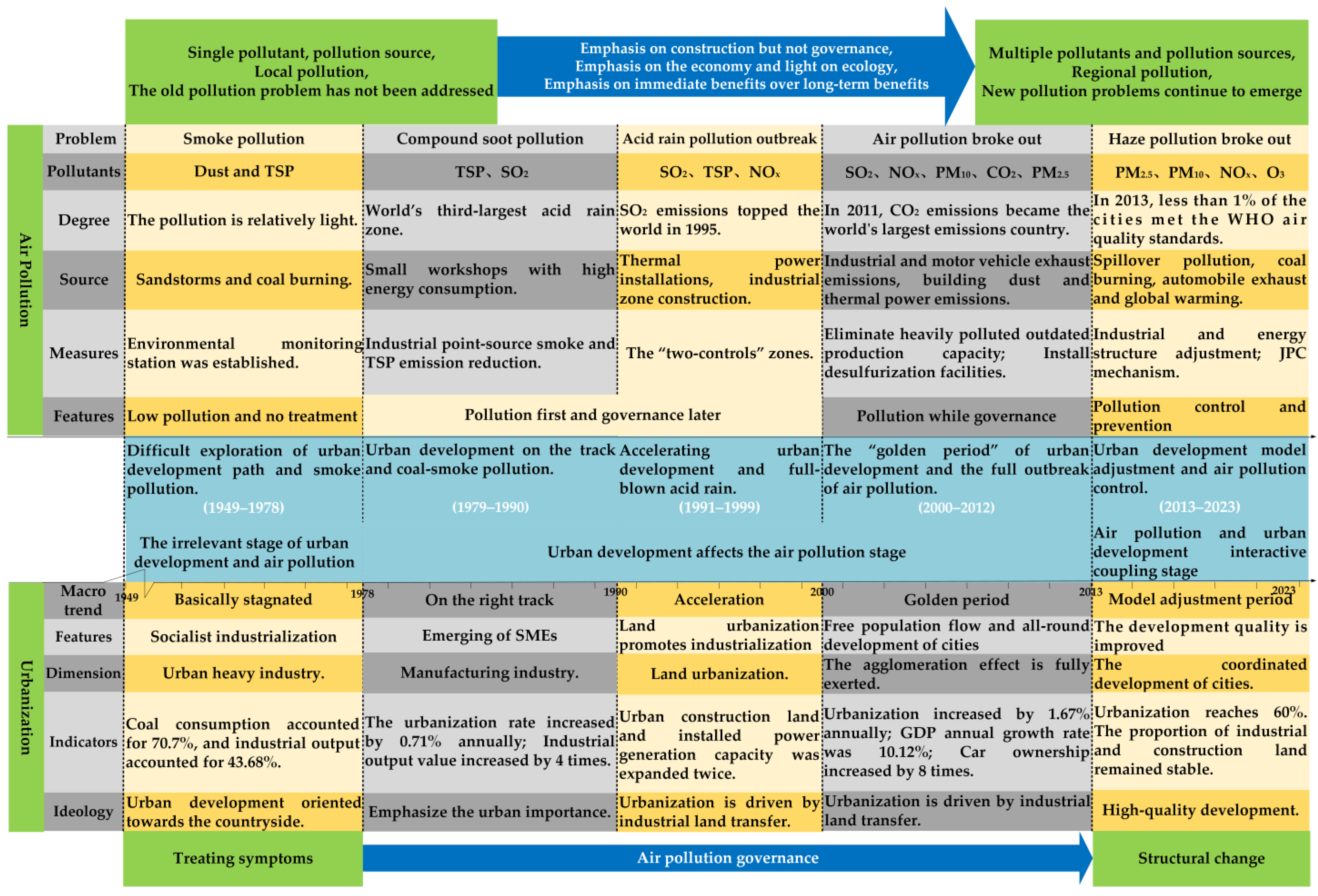
| Dimension | Feature | Trend | |
|---|---|---|---|
| Air Pollution | 1949~1978: Lighter air pollution, dominated by smoke and dust from TSP emissions 1979~1995: Increased air pollution and a rapid rise in emissions of various pollutants, especially TSP and SO2 1996~1999: The emission of various pollutants fell, and the problem of CO2 emissions began to emerge 2000~2012: The emission volumes of various pollutants increased rapidly, with some of them peaking, while TSP, SO2 and NOx decreased, and CO2 was the highest 2013~2023: The growth of CO2 emission slowed down, O3 increased, PM2.5, PM10, SO2 dropped, and NOx and CO increased in some cities | 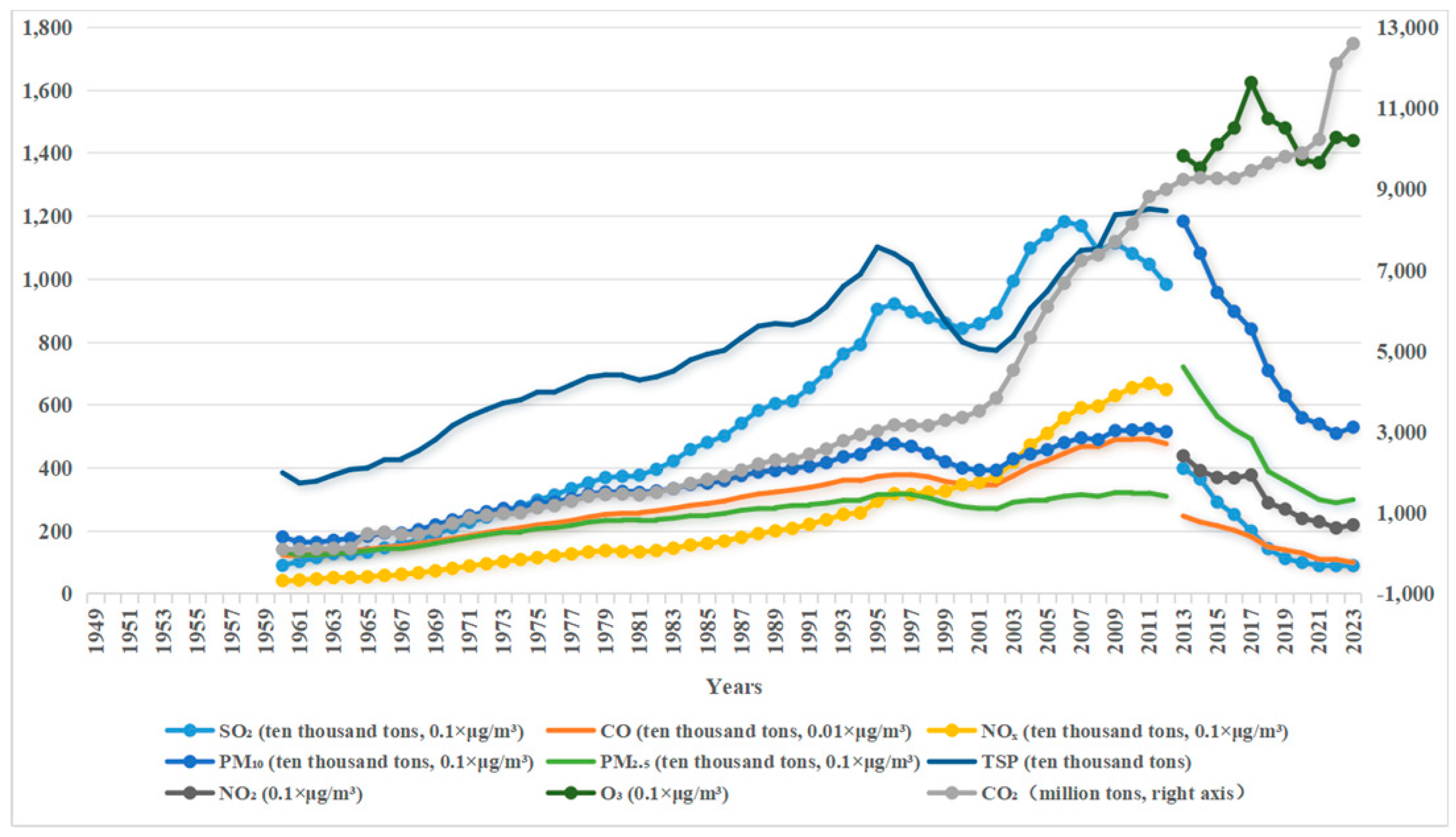 (a) China’s urban air pollution in the past 70 years | |
| Population development | City size | 1949~1982: The number and size of cities were strictly controlled 1983~1999: Rising number of cities and population, especially for small- and medium-sized cities 2000~2023: The total number of cities was fixed, the number of small cities decreased, and the number of large- and medium-sized cities increased |  (b) China’s city number and size in the past 70 years |
| Population size | 1949~1978: The urban population was small and mounted slowly 1979~1999: The urban population ascended significantly, and the population urbanization rate increased rapidly 2000~2023: The population urbanization rate was accelerating, the urban population was accelerating, and the population density was on the rise | 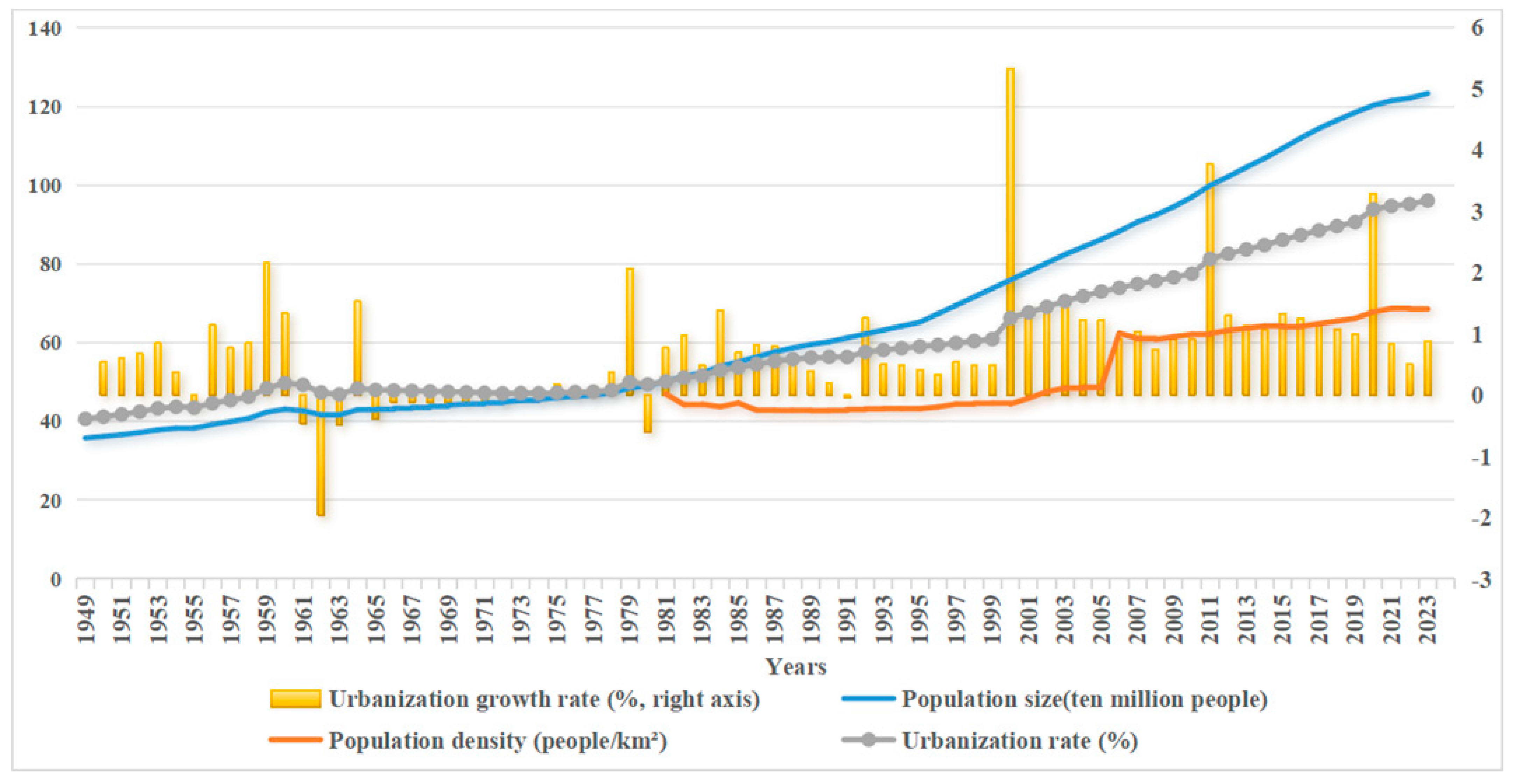 (c) China’s urban population development in the past 70 years | |
| Economic development | Economic growth | 1949~1978: The level of economic development was low, the proportion of tertiary industry was low 1979~2005: The level of economic development soared, the proportion of tertiary industries started to increase 2006~2023: The economic growth rate increased rapidly, the proportion of tertiary industry surpassed secondary industry, and the wealth of residents rocketed upwards | 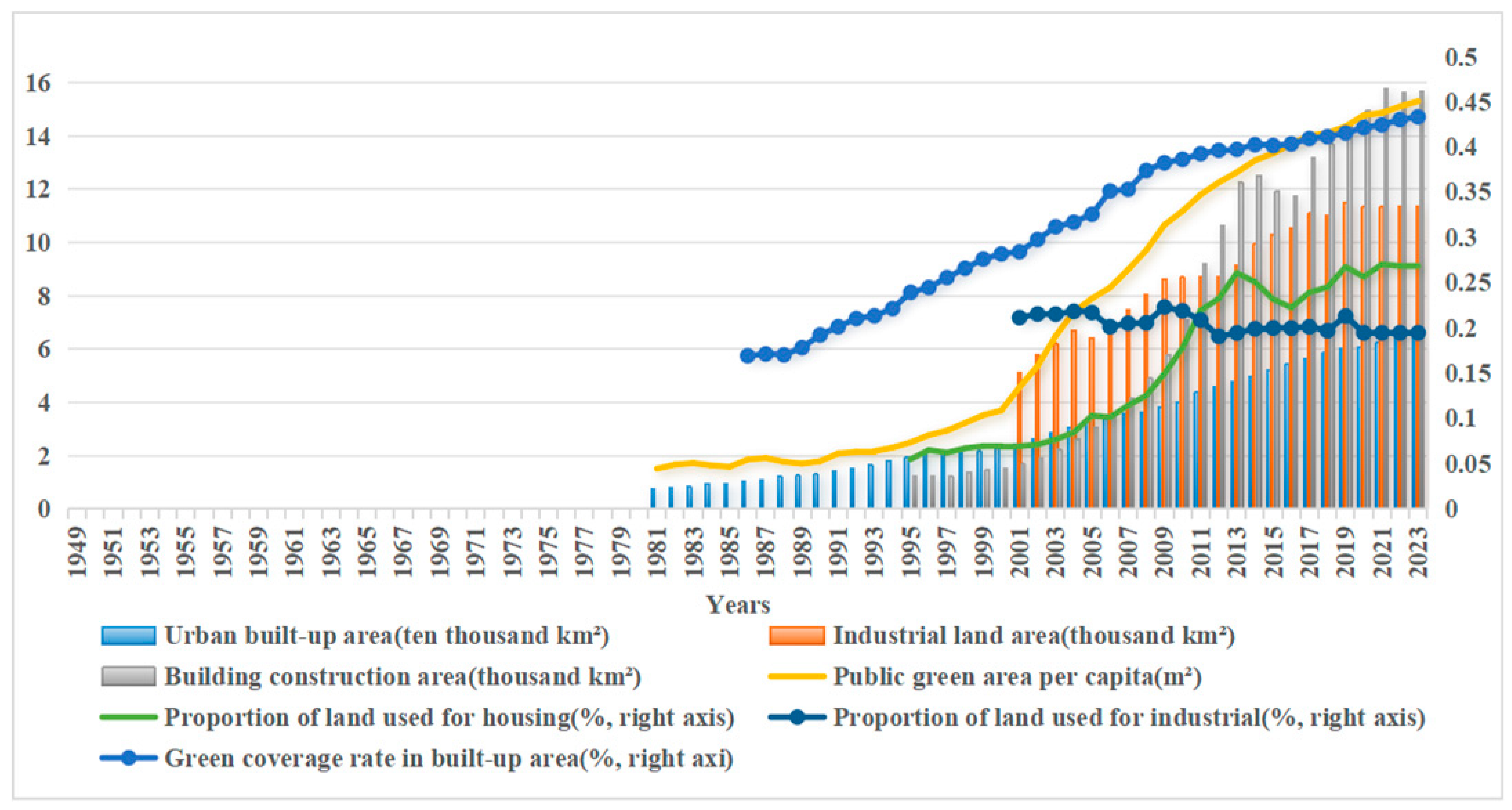 (d) China’s urban economic growth in the past 70 years |
| Energy consumption | 1949~1978: Total energy consumption increased, coal consumption increased slightly, and crude oil consumption went down slightly 1979~1999: Total energy consumption increased, coal consumption increased slightly, and crude oil consumption slid slightly 2000~2023: The total energy consumption increased rapidly, coal consumption decreased rapidly, and the proportion of clean energy consumption increased. | 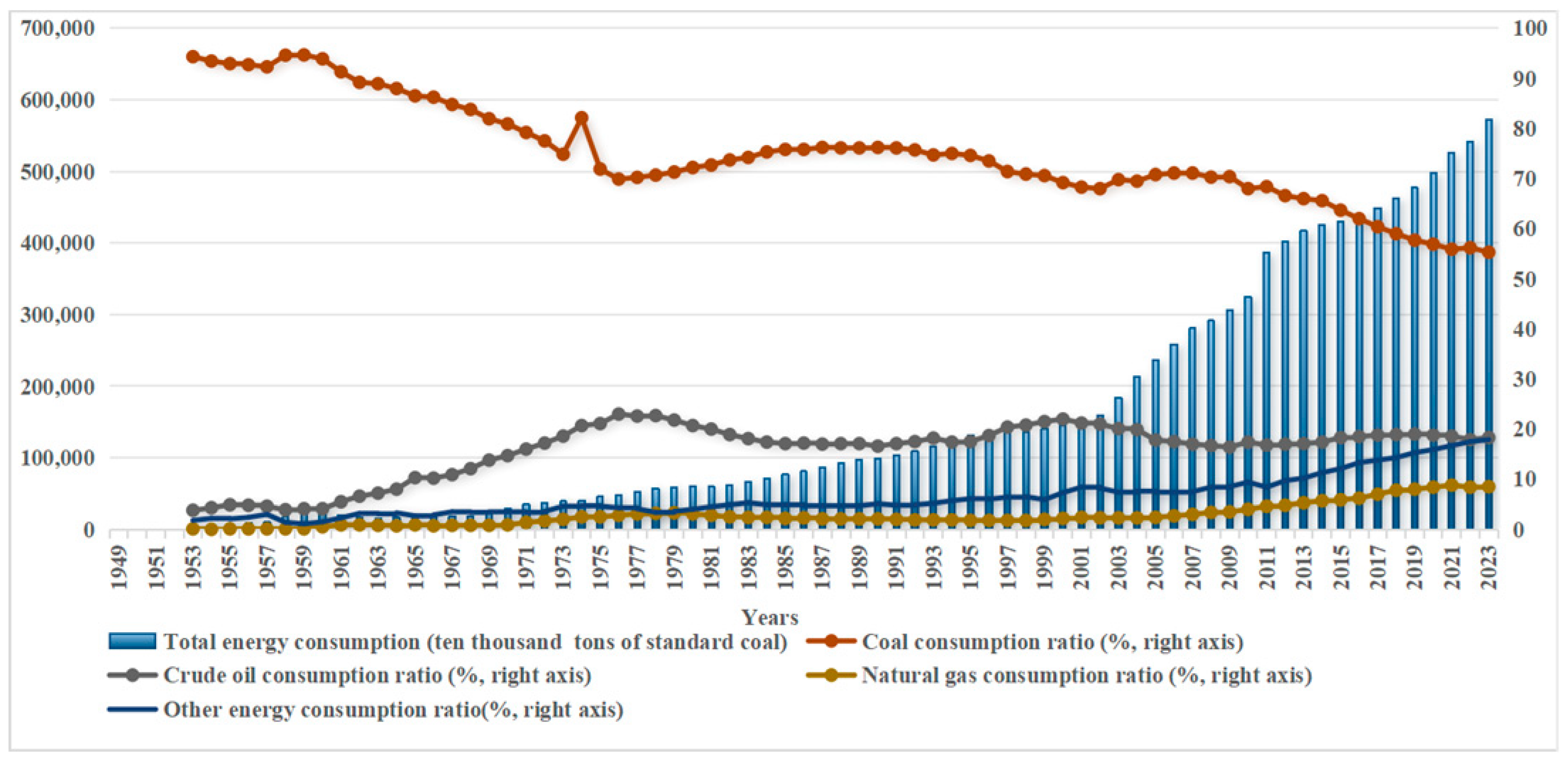 (e) China’s urban energy consumption in the past 70 years | |
| Space development | 1949~1980: Statistics were missing 1981~1999: The built-up area was small, with more industrial land, less residential land and low greening coverage rate 2000~2012: The urban construction area expanded rapidly, the proportion of housing construction land increased sharply, the proportion of industrial land showed a small fluctuation in decline, and the greening coverage rate continued to rise 2013~2023: The proportion of housing construction land decreased, the proportion of industrial land and the greening coverage rate of built-up area were basically fixed |  (f) China’s urban space development in the past 70 years | |
| Social development | 1949~1971: Statistics were missing 1972~1985: The infrastructure construction, such as household energy and public transport, was backward, and car ownership was extremely low 1986~2000: The household energy consumption continued to increase, the public transportation continued to improve, and car ownership surged 2001~2023: The construction of public transportation was improved rapidly, car ownership soared, and the household energy consumption declined | 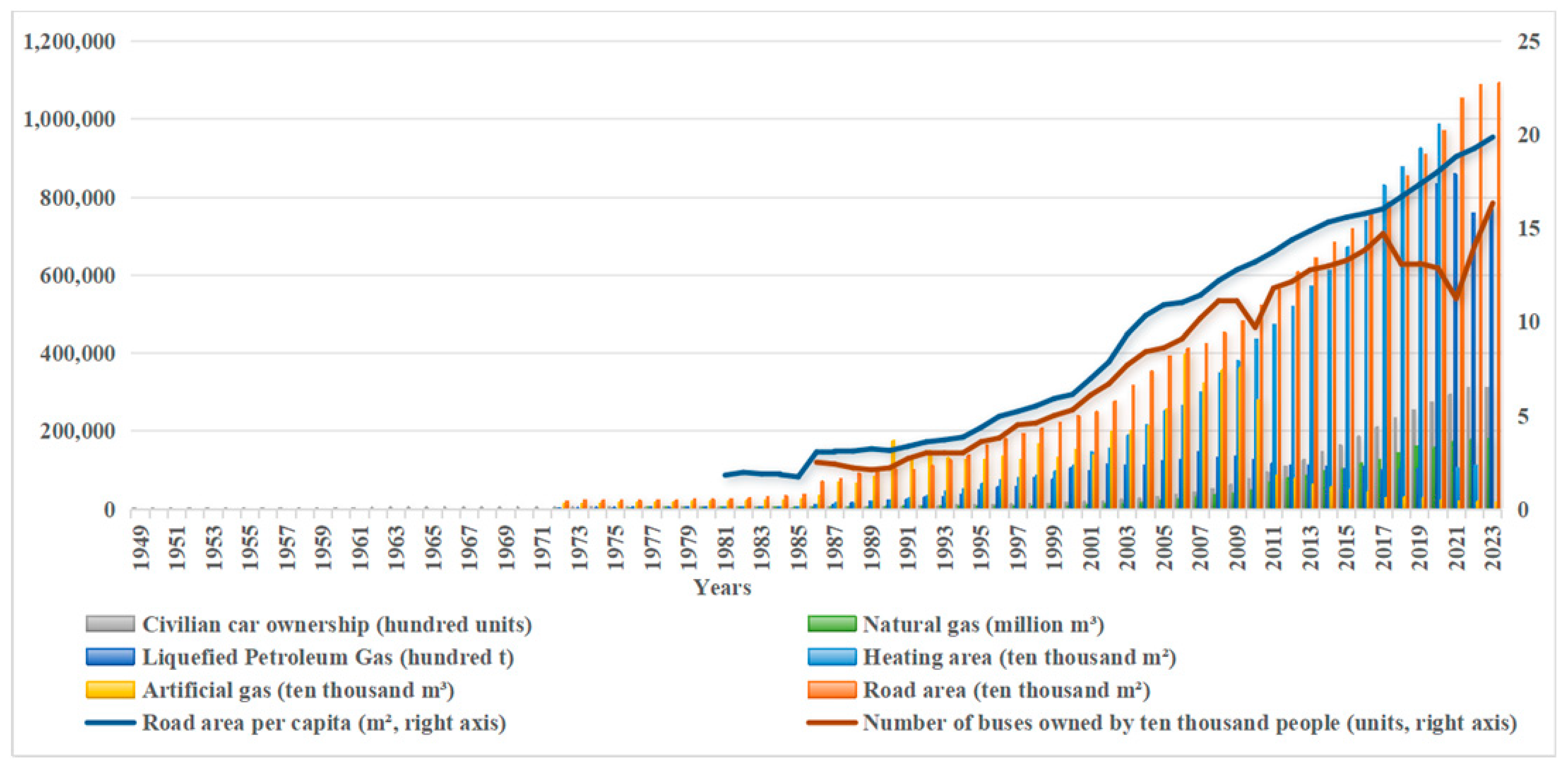 (g) China’s urban social development in the past 70 years | |
| Interactive Stage | Interactive Features | Urbanization | Air Pollution | Policy Considerations |
|---|---|---|---|---|
| 1949~1978 | Difficult exploration of urbanization path and smoke pollution. | The population urbanization rate was around 17%. The per capita GDP was below CNY 400 for a long time. | The average annual emission of other pollutants was below 2 million tons; the average annual emission of TSP was above 5 million tons. | The R&O (1978). |
| 1979~1990 | Urbanization on the track and coal-smoke pollution. | The population urbanization rate increased by 0.71% annually; the per capita GDP increased by 4 times; the built-up area increased by 72.83% annually; the area of central heating increased by 2 times. | The annual average SO2 emissions increased by 216,200 tons, the fastest growth; the average annual emissions of TSP were 7.6 million tons, the largest emissions. | The rapid development of small cities and SMEs. |
| 1991~1999 | Accelerating urbanization and full-blown acid rain. | The population urbanization rate increased to more than 30%; the GDP scale increased by 4 times; the urban construction land increased by 2 times; the number of motor vehicles s increased by 2.35 times. | SO2 emissions increased by an average of 275,400 tons per year. In 1999, it surpassed TSP and became the largest pollutant in China. | Accelerating spatial urbanization. |
| 2000~2012 | The “golden period” of urbanization and the full outbreak of air pollution. | The average annual growth rate of urbanization was 1.67%; the average annual GDP growth rate was 10.12%; the area of urban housing construction land increased by nearly 7 times; the number of motor vehicles increased by 8 times. | In 2006, SO2 emissions peaked; In 2011, China’s CO2 emissions surpassed that of the US; the annual growth rate of NOx, PM10 and CO emissions reached the historical maximum. | Urbanization in the new millennium began to accelerate in an all-round way. |
| 2013~2023 | Urbanization model adjustment and air pollution control. | The population growth rate slowed down; the built-up area growth rate was only 22.15%; the GDP growth rate entered the 6-digit era; the consumption of domestic energy and natural gas increased by 7.76% annually. | China’s urban PM2.5, PM10, SO2, CO and NO2 concentrations decreased by 50%, 47%, 72%, 44% and 39%, respectively, compared to those of in 2013. | China stepped into the stage of “improvement of air quality”. |
Disclaimer/Publisher’s Note: The statements, opinions and data contained in all publications are solely those of the individual author(s) and contributor(s) and not of MDPI and/or the editor(s). MDPI and/or the editor(s) disclaim responsibility for any injury to people or property resulting from any ideas, methods, instructions or products referred to in the content. |
© 2024 by the authors. Licensee MDPI, Basel, Switzerland. This article is an open access article distributed under the terms and conditions of the Creative Commons Attribution (CC BY) license (https://creativecommons.org/licenses/by/4.0/).
Share and Cite
Li, Z.; Zhao, K.; Yuan, X.; Zhou, Y.; Yang, L.; Geng, H. Evolution and Control of Air Pollution in China over the Past 75 Years: An Analytical Framework Based on the Multi-Dimensional Urbanization. Atmosphere 2024, 15, 1093. https://doi.org/10.3390/atmos15091093
Li Z, Zhao K, Yuan X, Zhou Y, Yang L, Geng H. Evolution and Control of Air Pollution in China over the Past 75 Years: An Analytical Framework Based on the Multi-Dimensional Urbanization. Atmosphere. 2024; 15(9):1093. https://doi.org/10.3390/atmos15091093
Chicago/Turabian StyleLi, Zhaopeng, Kai Zhao, Xiaoling Yuan, Yinan Zhou, Li Yang, and Hanyu Geng. 2024. "Evolution and Control of Air Pollution in China over the Past 75 Years: An Analytical Framework Based on the Multi-Dimensional Urbanization" Atmosphere 15, no. 9: 1093. https://doi.org/10.3390/atmos15091093





